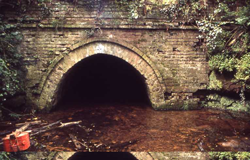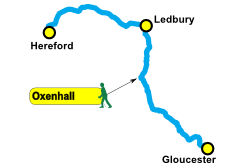Oxenhall Canal Tunnel, completed in 1798, extends northwards 2192 yards from here towards Dymock.

 Most of the original structure of the tunnel is still in standing but will need extensive restoration. The north end passes under the M50 motorway, which was constructed between 1958 and 1960. Here the tunnel at the end of a deep cutting near Boyce Court collapsed the portal is not visible. At the request of the H&GCT a high pressure gas transmission pipeline was built over the tunnel in 2008 on a concrete slab, to enable restoration work to be carried out at a later date.
Most of the original structure of the tunnel is still in standing but will need extensive restoration. The north end passes under the M50 motorway, which was constructed between 1958 and 1960. Here the tunnel at the end of a deep cutting near Boyce Court collapsed the portal is not visible. At the request of the H&GCT a high pressure gas transmission pipeline was built over the tunnel in 2008 on a concrete slab, to enable restoration work to be carried out at a later date.
In 1991 the Trust commenced restoration of the Canal at the south portal of Oxenhall Tunnel. With Waterway Recovery Group assistance, efforts were made to lower the water level and rebuild the towpath. Later, in 1994, the south portal of Oxenhall tunnel was cleared of vegetation and a start made on rebuilding the damaged portal structure. Work on the portal continued until it was completed in 1998.
Immediately south of the tunnel is the “Legger’s Rest”, a unique, arched recess built into the bank alongside the tunnel portal, where, history has it, the gang of men retained to assist passage of narrow boats through the tunnel, would await their next job. This structure was also fully restored in the 1990s.
Please note the tunnel is privately owned. Visitors are requested not to enter it as it could be hazardous.
 In 1996, the canal channel was dredged along a 290m length between Coldharbour Lane and end of the tunnel. All dredgings were spread on adjacent land giving the owner an extra acre of usable land. Unfortunately this stretch is not in the H&GCT ownership and is now overgrown from the tunnel to Coldharbour Bridge.
In 1996, the canal channel was dredged along a 290m length between Coldharbour Lane and end of the tunnel. All dredgings were spread on adjacent land giving the owner an extra acre of usable land. Unfortunately this stretch is not in the H&GCT ownership and is now overgrown from the tunnel to Coldharbour Bridge.
A short way from the tunnel is Coldharbour Bridge. As part of some of the first restoration work undertaken by Trust volunteers on the canal, the walls of the Canal beneath the bridge were strengthened with concrete and then re-faced with masonry.




